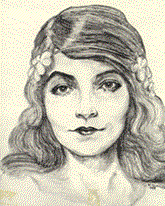Lillian Gish
 I will admit that silent films are difficult to watch today -- technology, culminating in the 24-hour availability of talking heads in our living rooms, has made us a dialogue-obsessed culture. One has to approach silent film today as if one is beginning to learn a new language, and to watch the earliest silent films is to be given an opportunity to watch a language actually coming into being.
I will admit that silent films are difficult to watch today -- technology, culminating in the 24-hour availability of talking heads in our living rooms, has made us a dialogue-obsessed culture. One has to approach silent film today as if one is beginning to learn a new language, and to watch the earliest silent films is to be given an opportunity to watch a language actually coming into being.Lillian Gish, born in Springfield, Ohio 112 years ago today, was perhaps the finest craftsman among actors of the cinema at the precise moment that D.W. Griffith, the first great American film director, began to shape his vision of the cinema as a legitimate art form. Thus, she became the focal point of Griffith's technical development -- his groundbreaking editing, lighting and close-ups. At a time when physical intimacy was reserved for the closest relationships of blood or marriage, filmgoers could stare into Lillian Gish's shining eyes at close range and see the trails of her tears projected at super-human scale on a screen. We are used to such representations of intimacy today, but for audiences at the beginning of the 20th century, the experience must have awakened unfamiliar fascinations.
Gish started acting in stage melodramas with her younger sister Dorothy at age 5, and traveled with touring stage companies throughout her youth. During a lean period in 1912 (legitimate stage actors normally wouldn't be caught dead trying to get work in the "flickers"), she and Dorothy turned up at the Biograph Studios looking for work, were recognized by their old friend Mary Pickford, and were cast by Griffith that afternoon in what became one of Griffith's classic short films, An Unseen Enemy. As Griffith's canvases became larger (in films such as Judith of Bethulia, 1914; The Birth of a Nation, 1915; Intolerance, 1916; Broken Blossoms, 1918; and True Heart Susie, 1919), Gish was his perfect heroine, looking like a fragile Victorian beauty but possessing indomitable inner strength, exposed in her delicate, often lyrical yet defiant gestures.
Griffith was also in love with her, but she never lost her head or took advantage of him; she gave him his due as commandant, but otherwise treated him as an intellectual equal, a partner in art. After appearing in two more of Griffith's last successes, Way Down East (1920, risking her life on ice floes near a waterfall) and Orphans of the Storm (1922), she broke with him over salary and had a string of successes before the advent of sound (notably The Scarlett Letter, 1926, and The Wind, 1928).
Turning 33 at the advent of sound film, she would never be a flapper, and rather than risk being treated as an antique, she returned to the New York stage, starring in revivals of Chekhov and Shakespeare (as "Ophelia" to Gielgud's Hamlet). She appeared in character roles in films from the 1940s onward, winning an Oscar nomination for Duel in the Sun (1946) and delivering a memorable performance in Night of the Hunter (1955), sitting in her rocking chair cradling a shotgun in her arms while awaiting a psychotic Robert Mitchum. She remained active into her 90s, observing, "I can't remember a time when I wasn't acting, so I can't imagine what I would do if I stopped now."
Labels: Silent Film





0 Comments:
Post a Comment
Subscribe to Post Comments [Atom]
<< Home